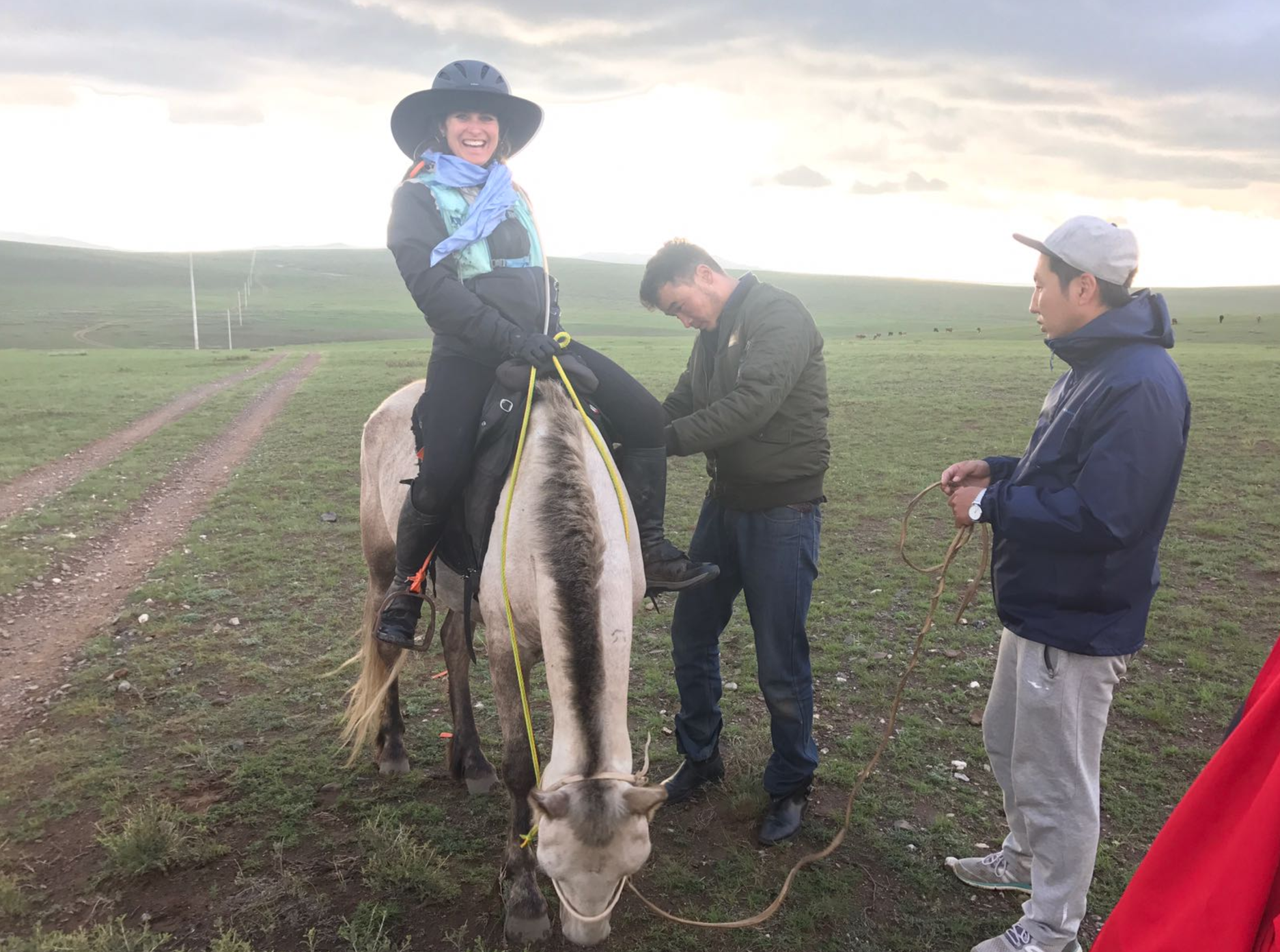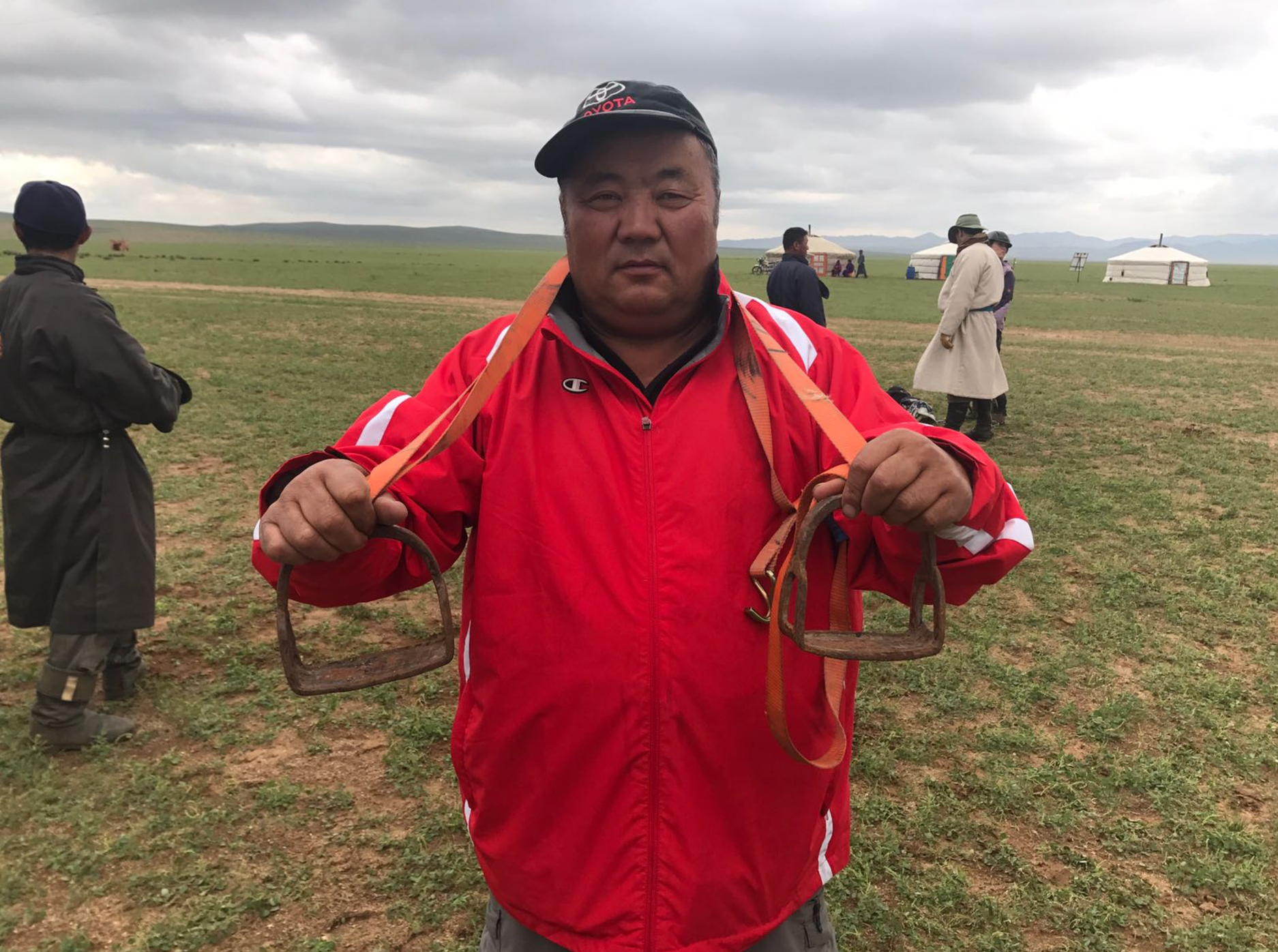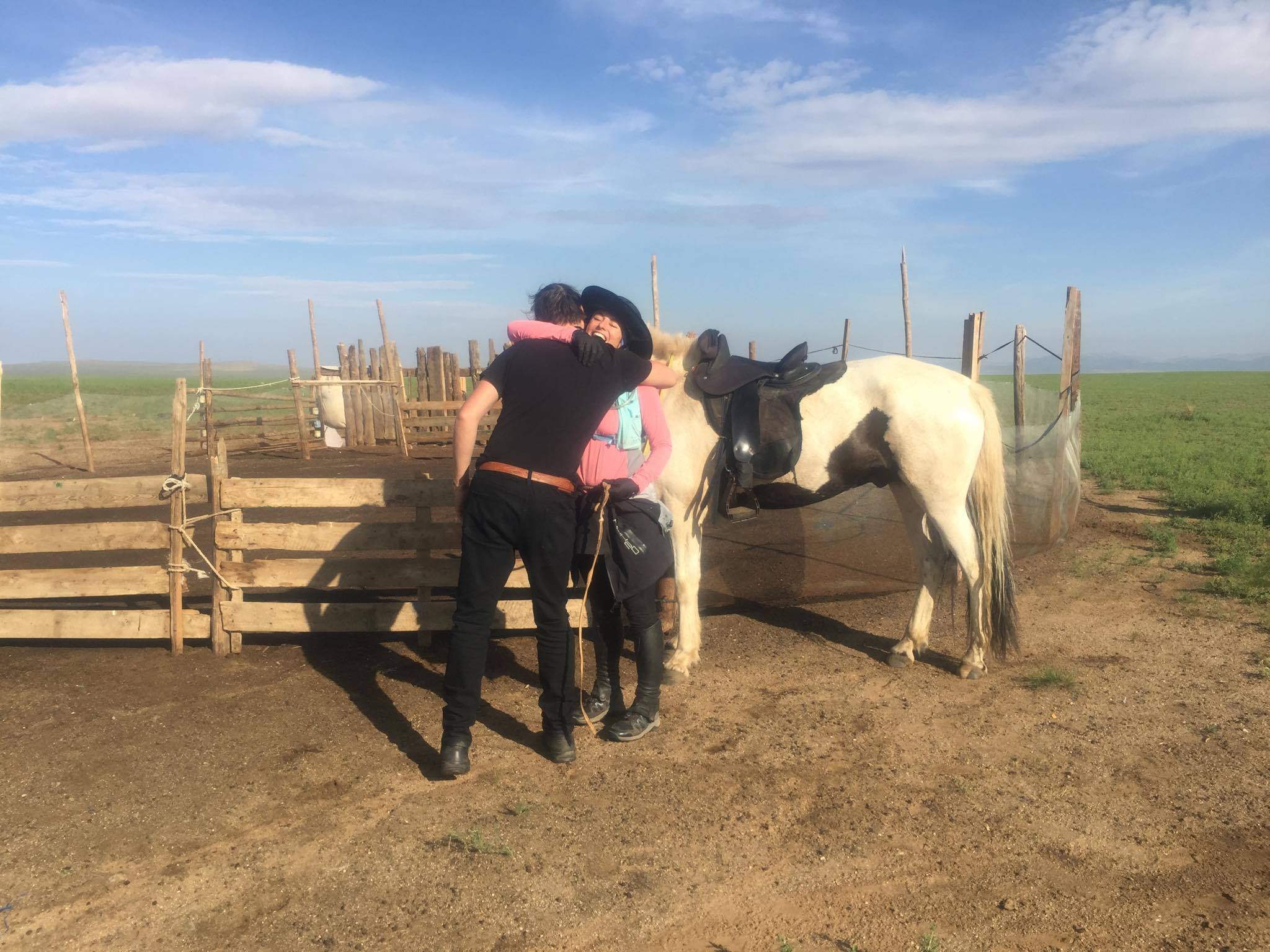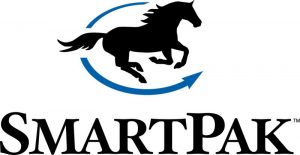
Wylie vs. the Mongol Derby, Powered by SmartPak: The Race, Part 3 – But Wait, It Gets Worse
After a horse ran away with her gear on day 3, Leslie Wylie wondered if she had anything left to lose. Answer: Yes, she did.
In August 2017 writer/rider Leslie Wylie conquered her most fearsome feat of #YOLO yet: a 620-mile race across Mongolia. Riding 27 semi-wild native horses. Carrying only 11 pounds of gear. Relying on nomads for food, water and shelter. On a mission to help stop deforestation.
Held Aug. 9-19, the Mongol Derby is widely regarded as the toughest horse race in the world. Inspired by the Genghis Khan’s original “pony express,” there’s no trail or set route, just 25 GPS checkpoints/horse exchange stations to hit over the course of 7-10 days. Now that Leslie is home she is recapping her ride of a lifetime! Click here to read previous stories in the series. New camel stirrups, check! All photos courtesy of The Adventurists/Mongol Derby.
New camel stirrups, check! All photos courtesy of The Adventurists/Mongol Derby.
Day 4
Day 4 dawned bright and full of naive promise at urtuu #9. A blood orange sun was yawning up from the horizon, casting sunbeams across the steppe that warmed the gers and backlit the horse line. Encircled by miles upon miles of nothing much at all, I felt like I was standing on the edge of the earth with no option but to jump.
After yesterday’s runaway horse debacle, things were looking up. It had been a pleasant night: Sleeping under a rug, in lieu of my gone-forever sleeping bag, hadn’t been half bad. And I’d gotten my first introduction to Mongolian dumplings, an absolute revelation, cloaking whatever mystery meat was on the menu in hand-rolled, pillowy dough so we didn’t have to look at it. Some of the swankier host gers even served them up with off-brand ketchup, a delicacy I liked to refer to as “wilderness ravioli.”
Another tremendous source of hope was the fact that I now possessed a pair of stirrups, or at least a couple stirrup-like objects, courtesy of crew member and acclaimed de-motivational speaker Hugh. Technically they were camel stirrups — big, rusty, medieval looking things; I’m pretty sure you could kill a man with one if you bonked him over the head with it. Hugh’s lackeys tied them onto my saddle with ratchet straps while he stood around, feeling manly.
I picked a black-and-white paint horse off the line and felt actual delight when he went bucking off with his herder. If I was going to make up for lost time today, I needed a horse with some spunk. Galloping out of the station behind Brits Cy and Paul, I felt like sticking my middle finger toward the sky: You can’t stop THIS girl, Mongol Derby puppet masters!
We’d only gone a kilometer or two before my optimism was interrupted by the clunk of a camel stirrup falling off. Well-played, puppet masters. Well-played.
I pulled up to address the wardrobe malfunction, insisting that Cy and Paul continue on and I’d try to catch up. I’d gotten off to fiddle with the stirrups when a cloud of dust came into view, heading my direction. It was Erik and the bloodwagon!
Erik is like the friend who shows up on your doorstep with pizza, wine and complete Golden Girls box set just when you need him the most. In this case he and his crew showed up with real stirrups and fenders, hand-me-downs from Julia Fisher, an American rider who sadly fell and broke a rib on day one.
I couldn’t have been more excited. Finally, something was going my way. After getting the new stirrups on, I mounted up and set back out on course. My horse picked up a brisk canter and I swiveled around to wave a cheerful goodbye to Erik and his crew. The documentary cameraman, who’d been recording #stirrupgate as it unfolded, focused his lens on us; at least this particular storyline of his film would have a happy ending.
And that was the exact moment when the paint bucked me off.
This time, I didn’t even try to hang on to the leadrope. I stood up, shook my fist at the horse as went buck-farting away, and collapsed back down to the ground in defeat. You’ve got to be kidding me.
Meanwhile, Erik sprang into action, ordering everyone back into the bloodwagon. They sped off after the horse, Erik leaning out the window while the filmmaker kept hold of his belt to keep him from falling out the door. “Get me closer!” he yelled to the driver, reaching toward the horse’s reins.
What happened next, some combination of fancy minivan maneuvering and a human wall that resulted in my horse inside a goat pen (looking not-at-all guilty for the havok he’d wrecked), still doesn’t quite add up in my mind.
Feeling like I’d just woken up from some hilarious dream, I hugged Erik and climbed back on the paint. You can’t stop THIS girl, Mongol Derby puppet masters. Although, point taken, you sure can slow me down. But the biggest speed bump was yet to come. As the leg wore on the paint began to feel like a Walkman with a dying battery, the music playing slower and slower, its melody stretched apart like taffy until there’s nothing left but a sticky flatline drone. His reluctant canter gave way to a lethargic trot, which soon dissolved to a walk, and no amount of kicking or verbally coaxing or swinging my rope around would speed him up.
But the biggest speed bump was yet to come. As the leg wore on the paint began to feel like a Walkman with a dying battery, the music playing slower and slower, its melody stretched apart like taffy until there’s nothing left but a sticky flatline drone. His reluctant canter gave way to a lethargic trot, which soon dissolved to a walk, and no amount of kicking or verbally coaxing or swinging my rope around would speed him up.
I kept hoping I’d run into another rider, and to be fair I did. Lucy and her horse pulled up a few kilometers in when her horse began having seizures, rearing up and flipping over backwards on top of her during one episode. She summoned the vets and they were there now, treating him. Unable to help, I wished them well and soldiered on.
Things got pretty bleak over the next few hours. When the paint’s walk slowed to something barely faster than a standstill, I dismounted to drag him along on foot, walking some 13 miles across the vast expanse of sand, scrubgrass and sun.
I was in trouble. It was hot, and my hydration pack was empty. I knew I should be sweating, but my skin was hot and dry. My energy was dwindling and I had no food. I knew my Garmin GPS batteries were running low (the extras had been in my saddlebag), so I only turned it on every couple miles to make sure I was still on track. If the batteries died and I was in the middle of nowhere … I avoided completing the thought. Even my senses seemed to be failing, depth perception for instance: the further we walked, the further away the mountain I was aiming for seemed to get.
At first, I wasn’t sure if it was real or hallucination when I saw a figure heading toward us across the steppe. As it got closer I realized that it was a herder on a motorcycle, and my heart clenched with fight-or-flight adrenaline. Riders have gotten robbed and even sexually assaulted during the Derby — I myself had woken up at 5 a.m. one morning during start camp to a drunk herder trying to get in bed with me — and my vulnerability in this moment especially was not lost on me. Two things that I’d kept on my person rather than in my saddle bag were pepper spray and a knife, and I clutched one in each fist as he pulled up in front of me.
Fortunately, I didn’t need them. The herder’s friendly, toothless smile quickly disarmed my defenses — he was clearly just concerned that I was off my horse and had wanted to make sure everything was OK. Unable to communicate that the paint was just a deadbeat, I handed him the leadrope to hold while I mounted back up, only to jump back off again when he was out of sight.
The miles dragged on and on. I kept my eyes forward but allowed my mind to wander, under one condition: positive thoughts only. I imagined my husband Tommy bringing me coffee in bed at home, our buff-colored kitten purring into the crook of my arm. I heard my 2-year-old blue-eyed nephew, Cade, imparting his favorite advice: “Be safe on road!” I felt my fingers in my pony Princess’ silky mane, and smelled the honeysuckle that permeates summertime in Tennessee.
Finally, we made it to the mountain, and a solid nine hours after we started we found horse station #10. The paint and I parted ways, both overjoyed to be rid of one another.
After a long day of solitude, I couldn’t believe my good fortune: Clare and Rachel, my South Carolina comrades, were at the station! They were riding the race as a team and had been clocking steady progress. When Rachel heard about my lost kit she scooped me under her wing, setting me up with some electrolytes, painkillers and chafe cream — three direly-needed items. Her kindness and generosity put a lump in my throat.
There was time enough in the day for one more leg, and I set off from horse station #10 in a much happier state of mind than I’d arrived. Trotting behind Clare and Rachel into a fresh landscape of crisp green hills, gazing out between the ears of a horse who was NOT the paint, I felt some hope creeping back in. Maybe I could do this. Maybe it was going to be OK.
Horse station #11 was one of two penalty urtuus on the course and resultingly a sizeable group of riders had stalled out there, serving time for veterinary or other infractions (my vet card was clean but I owed an hour for outside assistance). James, Clare, Erik, myself and Rachel with herding families and crew at horse station #11.
James, Clare, Erik, myself and Rachel with herding families and crew at horse station #11.
The mood of the camp was upbeat. The smell was, em, “ripe” with the aroma of riders who hadn’t seen a shower since start camp. Dinner was a show-and-tell of battle scars and stories. We tried to piece together where we were in the field, who was in front of us and who was behind, a mental exercise akin to keeping track of swimmers in a pool full of talcum powder. Comparing notes at horse stations was our only means of making head or tail of the chaos.
Unlike the Hunger Games, the faces of the Derby’s fallen soldiers weren’t projected in the sky each night accompanied by cannonfire and dramatic music. I was surprised and terribly sorry to hear about the five riders who had already come out of the race, but excited to (gently) hug two of them at #11: Julia, patron saint of my stirrups, and Jane Boxhall, who suffered a concussion on the fourth leg. In a display of true sportsmanship, both women came back out to the field to assist in the bloodwagon and lend moral support. Jane set me up with a few odds and ends from her kit, including my new DIY saddlebag, an oversized possum-hair sock.
I think that up until horse station #11, the cold, harsh reality of the Derby hadn’t quite settled down on me. I’d been chugging along in my own little bubble, oblivious to the more serious accidents and injuries that other riders had encountered. If the worst that happened to me in this race was the loss of my gear, some heat exhaustion and a slowpoke pony, I’d be lucky. But it was still early in the race — we weren’t even to the halfway point yet. Anything could happen, and I couldn’t help but wonder when my number might be up.
There was one more heartbreaking casualty still to come that evening. I was watching North Carolina firecracker Marianne Williams approach the station, eager to give her a reunion squeeze, when her horse went down in a marmot hole just a couple hundred meters out. She lay motionless as the horse got up without her.
Luckily the medical team couldn’t have been closer and they stabilized her quickly, pitching a tent around her and making her comfortable until the ambulance could arrive later that night. A broken collarbone, it sounded like.
Feeling helpless, I walked out to Marianne at dusk with some milk tea and well-wishes. As the sun disappeared and gave way to a moonless night, I lingered outside the tent, listening as she flirtatiously cracked jokes to the doctor. Meanwhile the gers had gone quiet, everyone lying shoulder-to-shoulder in their sleeping bags, simultaneously together and alone in the dark. After an interminably long day of fighting back tears, I finally let one slip.








Leave a Comment